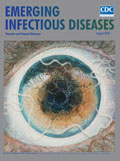
Volume 24, Number 8—August 2018
Letter
Visceral Leishmaniasis in Traveler to Guyana Caused by Leishmania siamensis, London, UK
On This Page
To the Editor: In a case report of visceral leishmaniasis in a traveler returning from Guyana, Polley et al. identified Leishmania siamensis as the causative agent (1). However, we believe that the parasite responsible for this infection has been misidentified. Classification of parasites formerly identified as L. siamensis has recently been revisited (2) after description of a new species (L. martiniquensis) from the West Indies (3). All previously described L. siamensis strains, except 1, are now reported as L. martiniquensis. Their rDNA internal transcribed spacer 1 sequences are still deposited in GenBank under the name L. siamensis. The exception, reported from Thailand (GenBank accession no. JX195640), is the only known L. siamensis sample to date.
New analysis of Leishmania (Mundinia) sequences available in GenBank and of L. infantum showed no variability in L. martiniquensis, including the sequence (GenBank accession no. LT577674) reported by Polley et al. (1), and sequence divergence when compared with L. siamensis (32.4%), a Leishmania sp. from Ghana (32.3%) (4), L. enrietti (30.6%), and L. infantum (43.6%). L. martiniquensis has been reported worldwide (Florida, West Indies, central Europe, and Southeast Asia). However, L. siamensis has been reported only once (in Thailand).
If one considers possible quiescence of the parasite, and that the patient was from Guyana, migrated to the United Kingdom in 1967, and had a relevant travel history, including visits to France (2003), Ghana (2005), Caribbean Grenada (2012), and Guyana (2012 and 2013), the geographic origin of this infection is unknown. Moreover, the mode of transmission of L. martiniquensis is not yet clearly defined. In contrast to the report of Polley et al. (1), although the genus Sergentomyia could play a role in some foci of leishmaniasis, it has never been recorded in the Americas (5).
References
- Polley SD, Watson J, Chiodini PL, Lockwood DNJ. Visceral leishmaniasis in traveler to Guyana caused by Leishmania siamensis, London, UK. Emerg Infect Dis. 2018;24:155–6. DOIPubMed
- Leelayoova S, Siripattanapipong S, Manomat J, Piyaraj P, Tan-Ariya P, Bualert L, et al. Leishmaniasis in Thailand: a review of causative agents and situations. Am J Trop Med Hyg. 2017;96:534–42.PubMed
- Desbois N, Pratlong F, Quist D, Dedet JP. Leishmania (Leishmania) martiniquensis n. sp. (Kinetoplastida: Trypanosomatidae), description of the parasite responsible for cutaneous leishmaniasis in Martinique Island (French West Indies). Parasite. 2014;21:12. DOIPubMed
- Kwakye-Nuako G, Mosore MT, Duplessis C, Bates MD, Puplampu N, Mensah-Attipoe I, et al. First isolation of a new species of Leishmania responsible for human cutaneous leishmaniasis in Ghana and classification in the Leishmania enriettii complex. Int J Parasitol. 2015;45:679–84. DOIPubMed
- Maia C, Depaquit J. Can Sergentomyia (Diptera, Psychodidae) play a role in the transmission of mammal-infecting Leishmania? Parasite. 2016;23:55. DOIPubMed






















.png)











No hay comentarios:
Publicar un comentario